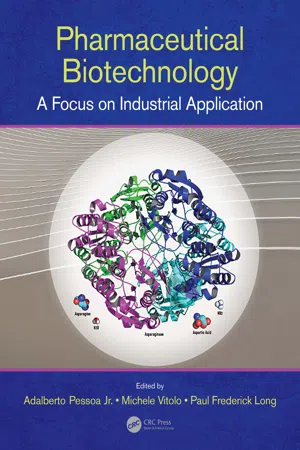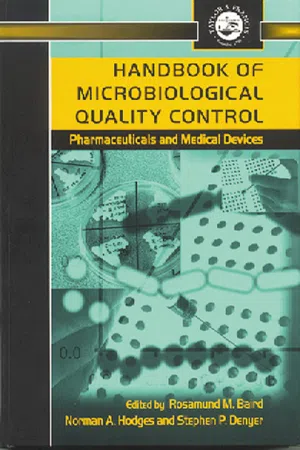Aseptic Techniques
Aseptic techniques are procedures used to prevent contamination of cultures or sterile materials by unwanted microorganisms. These techniques involve creating and maintaining a sterile environment, using sterile equipment and materials, and minimizing the risk of introducing contaminants. Aseptic techniques are crucial in biological sciences to ensure the integrity of experiments and the safety of researchers.
5 Key excerpts on "Aseptic Techniques"
- eBook - ePub
- John Twork, John Twork(Authors)
- 2020(Publication Date)
- CRC Press(Publisher)
...These sterilization methods have been applied in the rapidly growing biological process industries. The requirement for aseptic conditions in biological reactions, aseptic media fills, and final parenteral drug packaging is now regulated by agencies such as the Food and Drug Administration (FDA). The use of current good manufacturing practices (CGMPs) and good laboratory practices is designed to apply proper methods of sterilization for specific biological processes. _____________ * Present affiliation: Lear Siegler Measurement Controls Corporation, Englewood, Colorado At the present time, the art of aseptic sampling in biotechnical facilities is expanding, with equipment manufacturers offering manual and automatic sampling devices for installation in the biological fermentation equipment, bioreactors, tanks, and associated equipment. Standard procedures for performing aseptic sampling is primarily the responsibility of the user of the equipment, although some guidelines are provided by the equipment manufacturer and engineer/designer of the plant. However, a wide variation in methods for sampling these process equipment exists today, and more uniform methods and procedures are needed in the industry. The variety of processing and equipment requirements in this new industry complicates this goal as standardization efforts continue to grow. For example, the American Society for Testing and Materials (ASTM) has organized the E-48 Committee on Biotechnology during the past four years to address standard test methods and procedures for identification of microorganisms, terminology, and process control to containment, environmental, toxicity, and disposal issues. ASTM currently has a draft Standard Practice for Aseptic Sampling being developed for eventual use by the industry. Of the 5000 ASTM standards currently available, about 200 address sampling, but the E-48 committee is producing the first aseptic sampling standard practice for industrial application. B...
- eBook - ePub
- Julian Coleman, David Evans, Anne Kearns(Authors)
- 2020(Publication Date)
- Taylor & Francis(Publisher)
...Chapter 5 Culture facilities, sterile technique and media preparation 1. Introduction Successful plant tissue culture requires laboratory facilities where aseptic conditions can be established and maintained. Aseptic technique is critical for plant tissue culture practice because the media and the environment in which plant materials are grown, are also ideal conditions for microorganisms to proliferate. Fungal and bacterial contamination are amongst the hardest to deal with, as these organisms rapidly outgrow plant material and change the defined conditions of the growth medium resulting in poor growth or death of the plant culture. These deleterious effects are brought about by the contaminating organism(s) consuming the culture nutrients, excreting metabolites into the growth medium or colonizing the plant tissues. The basic Aseptic Techniques of handling and culturing plant materials were developed over many years and are designed to ensure that no contaminating micro-organisms enter the culture. Although not always essential, a carefully designed tissue culture unit is recommended to preserve sterile conditions and to achieve consistent results. 2. The basic laboratory layout and equipment The prime purpose of a tissue culture laboratory is to enable the processing and culture of plant material in a sterile environment. To facilitate this purpose, certain basic facilities are required...
- eBook - ePub
- Stuart Isaacs, Prof David Jennings(Authors)
- 2020(Publication Date)
- Garland Science(Publisher)
...4 Principles and Initial Steps in Culturing 4.1 Aseptic Techniques and manipulations The handling and culture of micro-organisms are carried out using Aseptic Techniques, the primary aims of which are to keep the test microbe in, and other microbes out of, the culture. This ensures that the microbial culture under test, the laboratory worker and the surroundings are kept free from contamination. At first, some of the operations may seem unwieldly and difficult to carry out but, as with other specialist techniques, practice helps to improve success rate. All apparatus and culture media must be sterilized prior to use, so that it is completely free from microbial contamination. Any equipment that comes into contact with microbes must also be sterilized after use and before disposal. It is most usual to sterilize laboratory equipment by heating with steam, under pressure (autoclaving) although a conventional pressure cooker can be used for small-scale sterilization. By heating at increased pressure, the temperature is raised above 100°C and therefore the time for which heating is required can be kept as short as possible. Autoclaving can affect the components of nutrient medium but the effect can be minimized (but not removed) by limiting the heating time. Normal autoclave conditions are 15 min at 121°C (15 lb in ‒2 ; 10 2 kPa). Temperature and pressure can be closely controlled. The sterilization chamber of the autoclave may be aligned vertically, most usual for large-capacity versions, or horizontally. During sterilization, solutions may boil vigorously and bubble within vessels. It is, therefore, advisable to place laboratory media and solutions for autoclaving in large containers, for example autoclave a 100 ml solution in a vessel with a 200–250 ml capacity. For autoclaving, screw caps of vessels should be placed on loosely and tightened after vessels have been removed from the autoclave, after sterilization...
- eBook - ePub
Pharmaceutical Biotechnology
A Focus on Industrial Application
- Adalberto Pessoa, Michele Vitolo, Paul Frederick Long, Adalberto Pessoa, Michele Vitolo, Paul Frederick Long(Authors)
- 2021(Publication Date)
- CRC Press(Publisher)
...A final subsection presents the validation requirements and methods for both upstream and downstream stages, essential to assure the quality and safety of biopharmaceuticals. 8.2 Terms and Definitions Many terms like sterility, disinfectant and antiseptic are used interchangeably to indicate a decrease/removal of (micro)organisms and other contaminants. However, it is important to distinguish them, as each term refers to the application and degree of safety of a specific hygienic procedure: Sterilization is the destruction of all viable organisms and microorganisms (including spores). In the case of drugs, these are considered sterile with a 10 −6 sterility guarantee. This value means that for every 10 6 sterile items in a final batch, there is a probability that there is only one viable microorganism (ANVISA, 2010); Antisepsis and disinfection are processes that inhibit growth or reduce the number of microorganisms. Antisepsis relates to procedures performed on living tissues (such as applying alcohol to a patient’s skin before an injection), while disinfection is associated with methods performed on inanimate objects (such as, the use of disinfecting agents on surfaces and equipment). Asepsis, on the other hand, is a term applied to designing hygiene methods and procedures to prevent contamination by microorganisms (McDonnell, 2020). For a complete understanding of the sterilization processes in the biopharmaceutical industry, it is important to be familiar with the terms related to the stability and resistance of the samples, namely: Thermolabile: indicates that a substance is sensitive to heat (i.e...
- Rosamund M. Baird, Norman A. Hodges, Stephen P. Denyer, Rosamund M. Baird, Norman A. Hodges, Stephen P. Denyer(Authors)
- 2000(Publication Date)
- CRC Press(Publisher)
...This may be accomplished by sterility testing actual product for say three batches under decreasing supervision with a sign-off based on satisfactory results. When stand-in operators need to refresh sterility test skills or interruptions in service take place, a revision and re-certification process should be devised. Aseptic procedures should be audited periodically (perhaps twice a year) to ensure that optimum methods are still being applied. Where isolators are being used, standards should still be maintained, even though with gassed systems and positive pressures, environmental contaminants are not expected. The difficulty in working with thicker gloves in an isolator means that the same high level of visual acuity and sustained concentration is necessary to compensate for a slight loss in manual dexterity and the additional need to protect the isolator envelope from damage from needles, etc. Also, although environmental contaminants are not expected, there is always a slight possibility that they may be present; Aseptic Techniques can readily reduce this risk. 8.2.6 Methods The pharmacopoeias are specific about test methods and when a pharmaceutical product licence reflects sterility tests according to British Pharmacopoeia, European Pharmacopoeia and United States Pharmacopoeia (BP, EP, USP) the use of the specified methods is the easiest way to comply. If a variation in some detail of the pharmacopoeial method is used, then equivalence should be established. The published methods basically rely on: use of specified microbiological broths to bathe the surfaces of containers declared as sterile, or immersion of items in broth, or mixing material with broth or retention of the micro-organisms on a filter and culture of the filter in broth...




